PHI-FP3200 - Health Care Problem Analysis: Malpractice and Negligence
VerifiedAdded on 2022/08/08
|6
|1575
|13
Essay
AI Summary
This essay provides an in-depth analysis of the ethical problem of malpractice and negligence within healthcare settings, focusing on a case involving a retained foreign object post-surgery. It explores the legal and ethical dimensions of such incidents, referencing the four components of adjudicating tort and medical practice: responsibility, breach of duty, causation, and damage. The analysis incorporates Kantian ethics, emphasizing the importance of duty and obligation over self-interest, and highlights the failure to adhere to the appropriate standard of care. The essay discusses the implications of such negligence, including increased financial costs, patient suffering, and family distress, and advocates for strategic planning and adherence to ethical principles to mitigate the occurrence of similar cases globally. The document is available on Desklib, a platform offering a wide range of study resources for students.
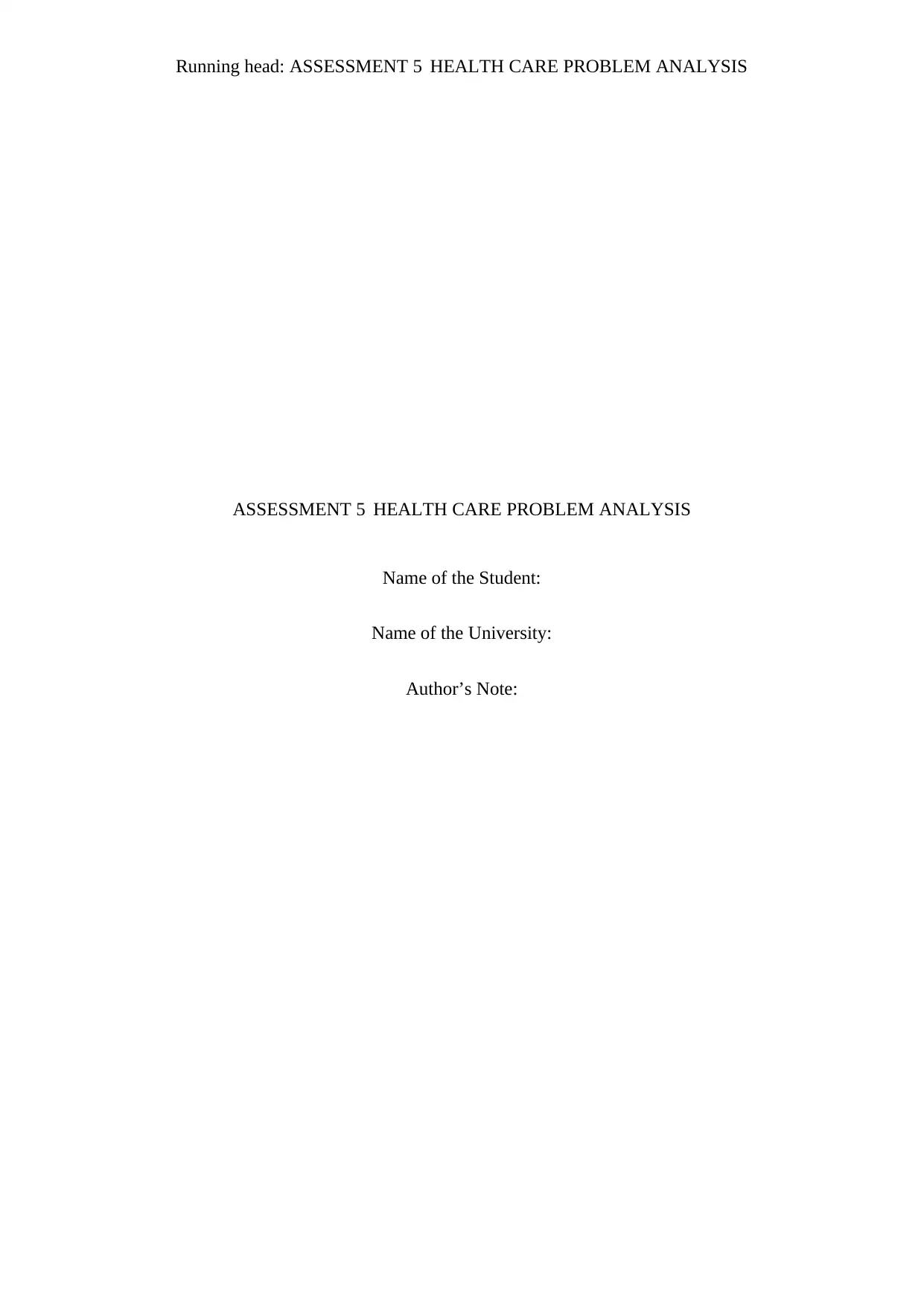
Running head: ASSESSMENT 5 HEALTH CARE PROBLEM ANALYSIS
ASSESSMENT 5 HEALTH CARE PROBLEM ANALYSIS
Name of the Student:
Name of the University:
Author’s Note:
ASSESSMENT 5 HEALTH CARE PROBLEM ANALYSIS
Name of the Student:
Name of the University:
Author’s Note:
Paraphrase This Document
Need a fresh take? Get an instant paraphrase of this document with our AI Paraphraser
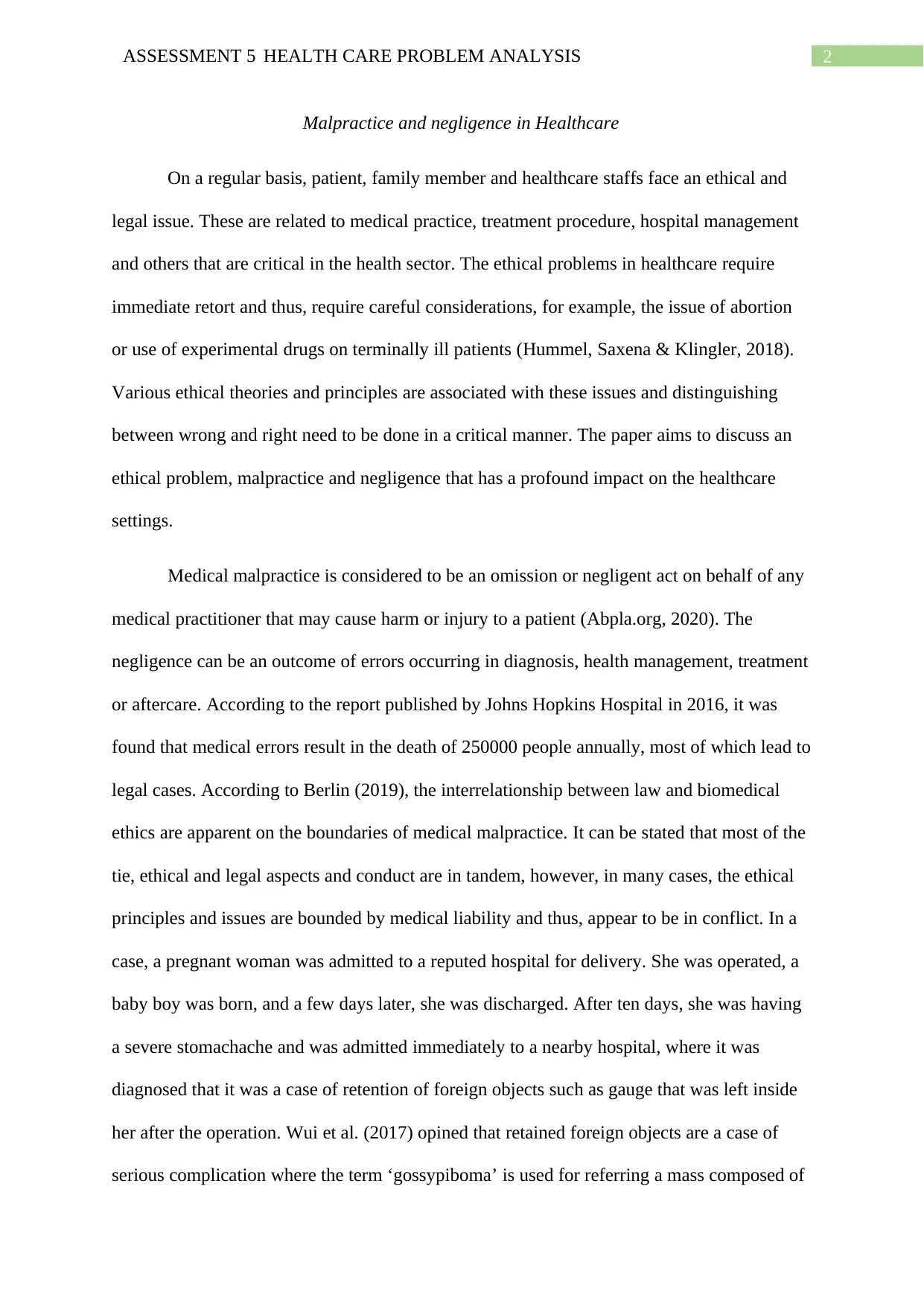
2ASSESSMENT 5 HEALTH CARE PROBLEM ANALYSIS
Malpractice and negligence in Healthcare
On a regular basis, patient, family member and healthcare staffs face an ethical and
legal issue. These are related to medical practice, treatment procedure, hospital management
and others that are critical in the health sector. The ethical problems in healthcare require
immediate retort and thus, require careful considerations, for example, the issue of abortion
or use of experimental drugs on terminally ill patients (Hummel, Saxena & Klingler, 2018).
Various ethical theories and principles are associated with these issues and distinguishing
between wrong and right need to be done in a critical manner. The paper aims to discuss an
ethical problem, malpractice and negligence that has a profound impact on the healthcare
settings.
Medical malpractice is considered to be an omission or negligent act on behalf of any
medical practitioner that may cause harm or injury to a patient (Abpla.org, 2020). The
negligence can be an outcome of errors occurring in diagnosis, health management, treatment
or aftercare. According to the report published by Johns Hopkins Hospital in 2016, it was
found that medical errors result in the death of 250000 people annually, most of which lead to
legal cases. According to Berlin (2019), the interrelationship between law and biomedical
ethics are apparent on the boundaries of medical malpractice. It can be stated that most of the
tie, ethical and legal aspects and conduct are in tandem, however, in many cases, the ethical
principles and issues are bounded by medical liability and thus, appear to be in conflict. In a
case, a pregnant woman was admitted to a reputed hospital for delivery. She was operated, a
baby boy was born, and a few days later, she was discharged. After ten days, she was having
a severe stomachache and was admitted immediately to a nearby hospital, where it was
diagnosed that it was a case of retention of foreign objects such as gauge that was left inside
her after the operation. Wui et al. (2017) opined that retained foreign objects are a case of
serious complication where the term ‘gossypiboma’ is used for referring a mass composed of
Malpractice and negligence in Healthcare
On a regular basis, patient, family member and healthcare staffs face an ethical and
legal issue. These are related to medical practice, treatment procedure, hospital management
and others that are critical in the health sector. The ethical problems in healthcare require
immediate retort and thus, require careful considerations, for example, the issue of abortion
or use of experimental drugs on terminally ill patients (Hummel, Saxena & Klingler, 2018).
Various ethical theories and principles are associated with these issues and distinguishing
between wrong and right need to be done in a critical manner. The paper aims to discuss an
ethical problem, malpractice and negligence that has a profound impact on the healthcare
settings.
Medical malpractice is considered to be an omission or negligent act on behalf of any
medical practitioner that may cause harm or injury to a patient (Abpla.org, 2020). The
negligence can be an outcome of errors occurring in diagnosis, health management, treatment
or aftercare. According to the report published by Johns Hopkins Hospital in 2016, it was
found that medical errors result in the death of 250000 people annually, most of which lead to
legal cases. According to Berlin (2019), the interrelationship between law and biomedical
ethics are apparent on the boundaries of medical malpractice. It can be stated that most of the
tie, ethical and legal aspects and conduct are in tandem, however, in many cases, the ethical
principles and issues are bounded by medical liability and thus, appear to be in conflict. In a
case, a pregnant woman was admitted to a reputed hospital for delivery. She was operated, a
baby boy was born, and a few days later, she was discharged. After ten days, she was having
a severe stomachache and was admitted immediately to a nearby hospital, where it was
diagnosed that it was a case of retention of foreign objects such as gauge that was left inside
her after the operation. Wui et al. (2017) opined that retained foreign objects are a case of
serious complication where the term ‘gossypiboma’ is used for referring a mass composed of
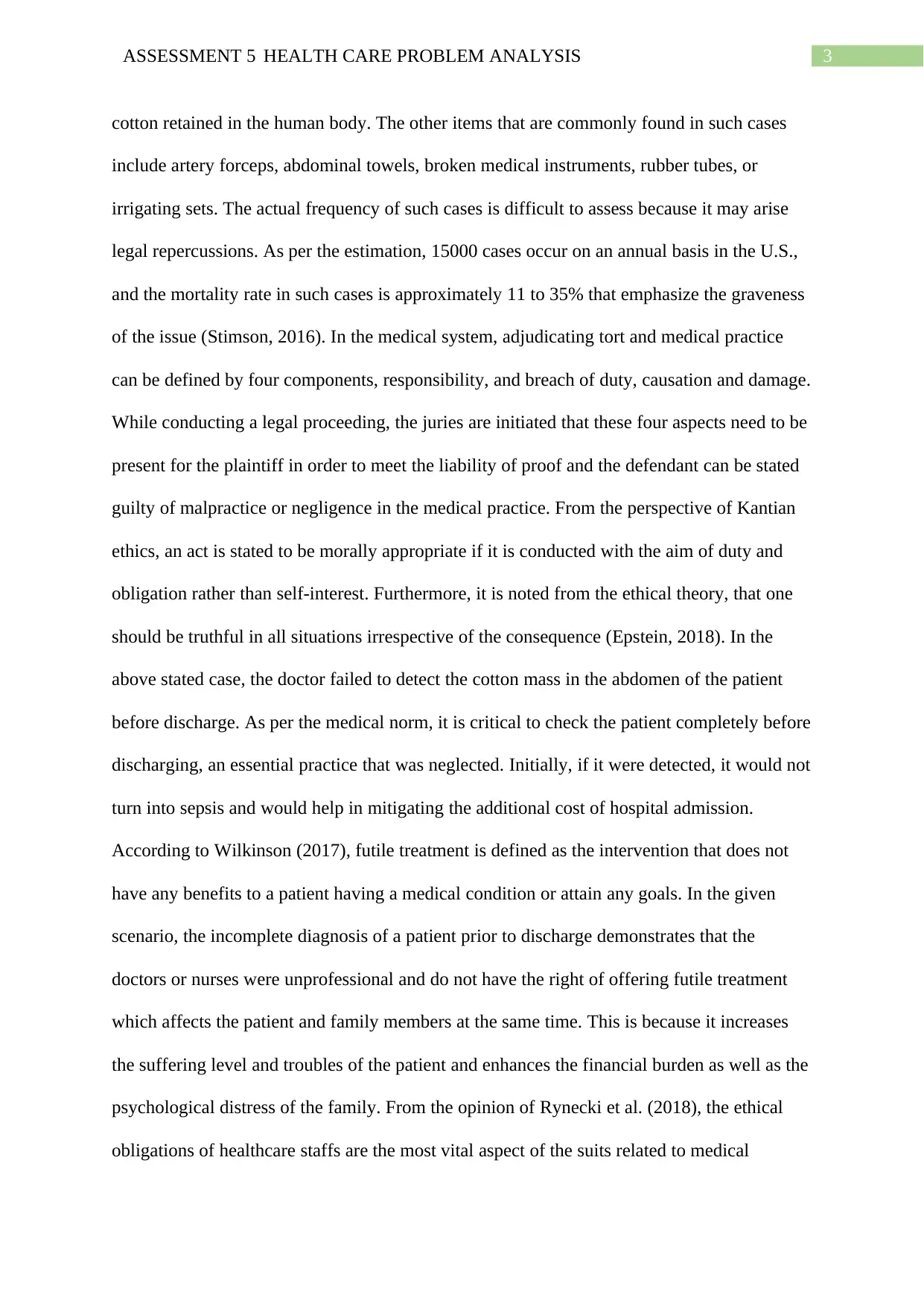
3ASSESSMENT 5 HEALTH CARE PROBLEM ANALYSIS
cotton retained in the human body. The other items that are commonly found in such cases
include artery forceps, abdominal towels, broken medical instruments, rubber tubes, or
irrigating sets. The actual frequency of such cases is difficult to assess because it may arise
legal repercussions. As per the estimation, 15000 cases occur on an annual basis in the U.S.,
and the mortality rate in such cases is approximately 11 to 35% that emphasize the graveness
of the issue (Stimson, 2016). In the medical system, adjudicating tort and medical practice
can be defined by four components, responsibility, and breach of duty, causation and damage.
While conducting a legal proceeding, the juries are initiated that these four aspects need to be
present for the plaintiff in order to meet the liability of proof and the defendant can be stated
guilty of malpractice or negligence in the medical practice. From the perspective of Kantian
ethics, an act is stated to be morally appropriate if it is conducted with the aim of duty and
obligation rather than self-interest. Furthermore, it is noted from the ethical theory, that one
should be truthful in all situations irrespective of the consequence (Epstein, 2018). In the
above stated case, the doctor failed to detect the cotton mass in the abdomen of the patient
before discharge. As per the medical norm, it is critical to check the patient completely before
discharging, an essential practice that was neglected. Initially, if it were detected, it would not
turn into sepsis and would help in mitigating the additional cost of hospital admission.
According to Wilkinson (2017), futile treatment is defined as the intervention that does not
have any benefits to a patient having a medical condition or attain any goals. In the given
scenario, the incomplete diagnosis of a patient prior to discharge demonstrates that the
doctors or nurses were unprofessional and do not have the right of offering futile treatment
which affects the patient and family members at the same time. This is because it increases
the suffering level and troubles of the patient and enhances the financial burden as well as the
psychological distress of the family. From the opinion of Rynecki et al. (2018), the ethical
obligations of healthcare staffs are the most vital aspect of the suits related to medical
cotton retained in the human body. The other items that are commonly found in such cases
include artery forceps, abdominal towels, broken medical instruments, rubber tubes, or
irrigating sets. The actual frequency of such cases is difficult to assess because it may arise
legal repercussions. As per the estimation, 15000 cases occur on an annual basis in the U.S.,
and the mortality rate in such cases is approximately 11 to 35% that emphasize the graveness
of the issue (Stimson, 2016). In the medical system, adjudicating tort and medical practice
can be defined by four components, responsibility, and breach of duty, causation and damage.
While conducting a legal proceeding, the juries are initiated that these four aspects need to be
present for the plaintiff in order to meet the liability of proof and the defendant can be stated
guilty of malpractice or negligence in the medical practice. From the perspective of Kantian
ethics, an act is stated to be morally appropriate if it is conducted with the aim of duty and
obligation rather than self-interest. Furthermore, it is noted from the ethical theory, that one
should be truthful in all situations irrespective of the consequence (Epstein, 2018). In the
above stated case, the doctor failed to detect the cotton mass in the abdomen of the patient
before discharge. As per the medical norm, it is critical to check the patient completely before
discharging, an essential practice that was neglected. Initially, if it were detected, it would not
turn into sepsis and would help in mitigating the additional cost of hospital admission.
According to Wilkinson (2017), futile treatment is defined as the intervention that does not
have any benefits to a patient having a medical condition or attain any goals. In the given
scenario, the incomplete diagnosis of a patient prior to discharge demonstrates that the
doctors or nurses were unprofessional and do not have the right of offering futile treatment
which affects the patient and family members at the same time. This is because it increases
the suffering level and troubles of the patient and enhances the financial burden as well as the
psychological distress of the family. From the opinion of Rynecki et al. (2018), the ethical
obligations of healthcare staffs are the most vital aspect of the suits related to medical
⊘ This is a preview!⊘
Do you want full access?
Subscribe today to unlock all pages.

Trusted by 1+ million students worldwide
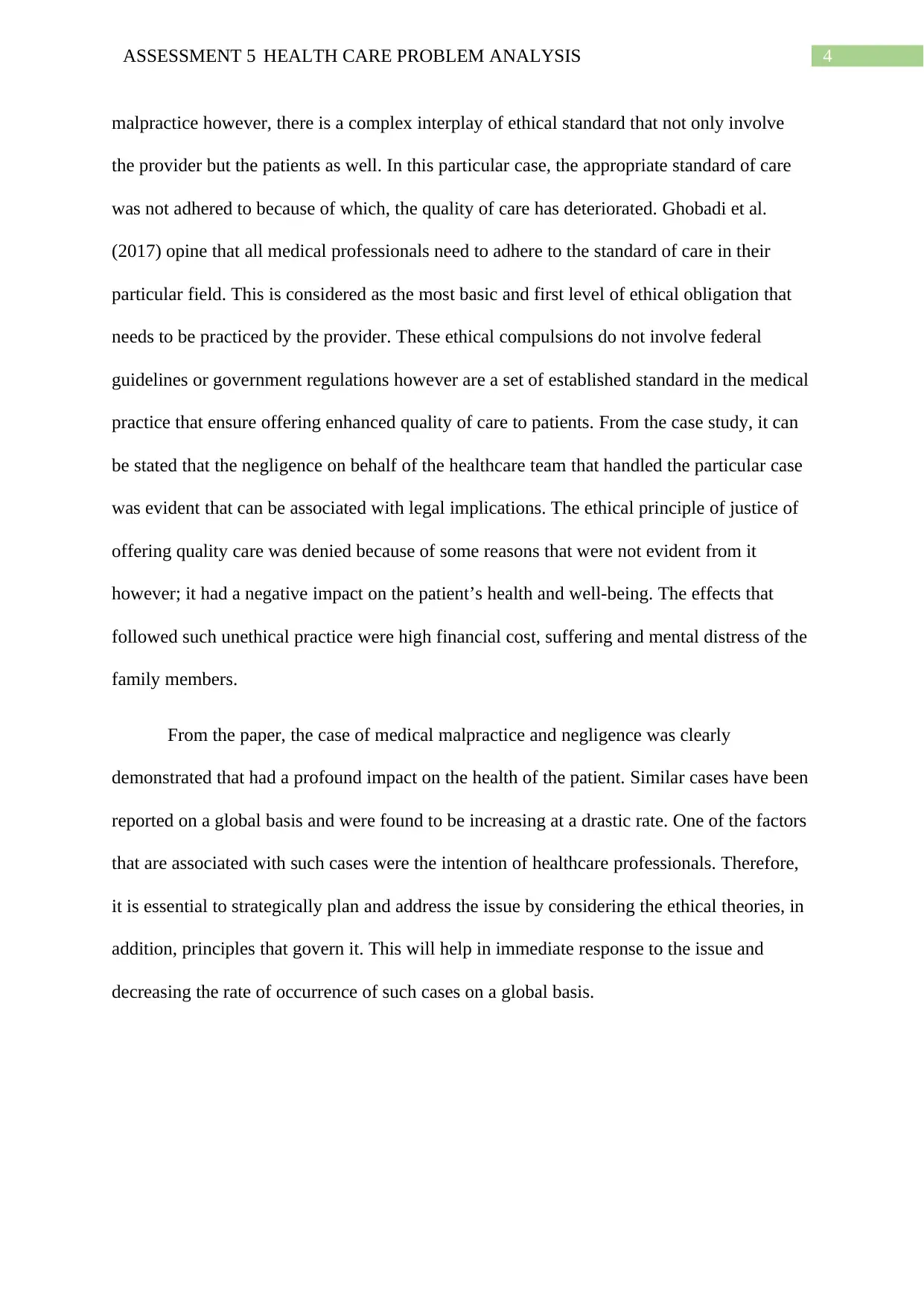
4ASSESSMENT 5 HEALTH CARE PROBLEM ANALYSIS
malpractice however, there is a complex interplay of ethical standard that not only involve
the provider but the patients as well. In this particular case, the appropriate standard of care
was not adhered to because of which, the quality of care has deteriorated. Ghobadi et al.
(2017) opine that all medical professionals need to adhere to the standard of care in their
particular field. This is considered as the most basic and first level of ethical obligation that
needs to be practiced by the provider. These ethical compulsions do not involve federal
guidelines or government regulations however are a set of established standard in the medical
practice that ensure offering enhanced quality of care to patients. From the case study, it can
be stated that the negligence on behalf of the healthcare team that handled the particular case
was evident that can be associated with legal implications. The ethical principle of justice of
offering quality care was denied because of some reasons that were not evident from it
however; it had a negative impact on the patient’s health and well-being. The effects that
followed such unethical practice were high financial cost, suffering and mental distress of the
family members.
From the paper, the case of medical malpractice and negligence was clearly
demonstrated that had a profound impact on the health of the patient. Similar cases have been
reported on a global basis and were found to be increasing at a drastic rate. One of the factors
that are associated with such cases were the intention of healthcare professionals. Therefore,
it is essential to strategically plan and address the issue by considering the ethical theories, in
addition, principles that govern it. This will help in immediate response to the issue and
decreasing the rate of occurrence of such cases on a global basis.
malpractice however, there is a complex interplay of ethical standard that not only involve
the provider but the patients as well. In this particular case, the appropriate standard of care
was not adhered to because of which, the quality of care has deteriorated. Ghobadi et al.
(2017) opine that all medical professionals need to adhere to the standard of care in their
particular field. This is considered as the most basic and first level of ethical obligation that
needs to be practiced by the provider. These ethical compulsions do not involve federal
guidelines or government regulations however are a set of established standard in the medical
practice that ensure offering enhanced quality of care to patients. From the case study, it can
be stated that the negligence on behalf of the healthcare team that handled the particular case
was evident that can be associated with legal implications. The ethical principle of justice of
offering quality care was denied because of some reasons that were not evident from it
however; it had a negative impact on the patient’s health and well-being. The effects that
followed such unethical practice were high financial cost, suffering and mental distress of the
family members.
From the paper, the case of medical malpractice and negligence was clearly
demonstrated that had a profound impact on the health of the patient. Similar cases have been
reported on a global basis and were found to be increasing at a drastic rate. One of the factors
that are associated with such cases were the intention of healthcare professionals. Therefore,
it is essential to strategically plan and address the issue by considering the ethical theories, in
addition, principles that govern it. This will help in immediate response to the issue and
decreasing the rate of occurrence of such cases on a global basis.
Paraphrase This Document
Need a fresh take? Get an instant paraphrase of this document with our AI Paraphraser
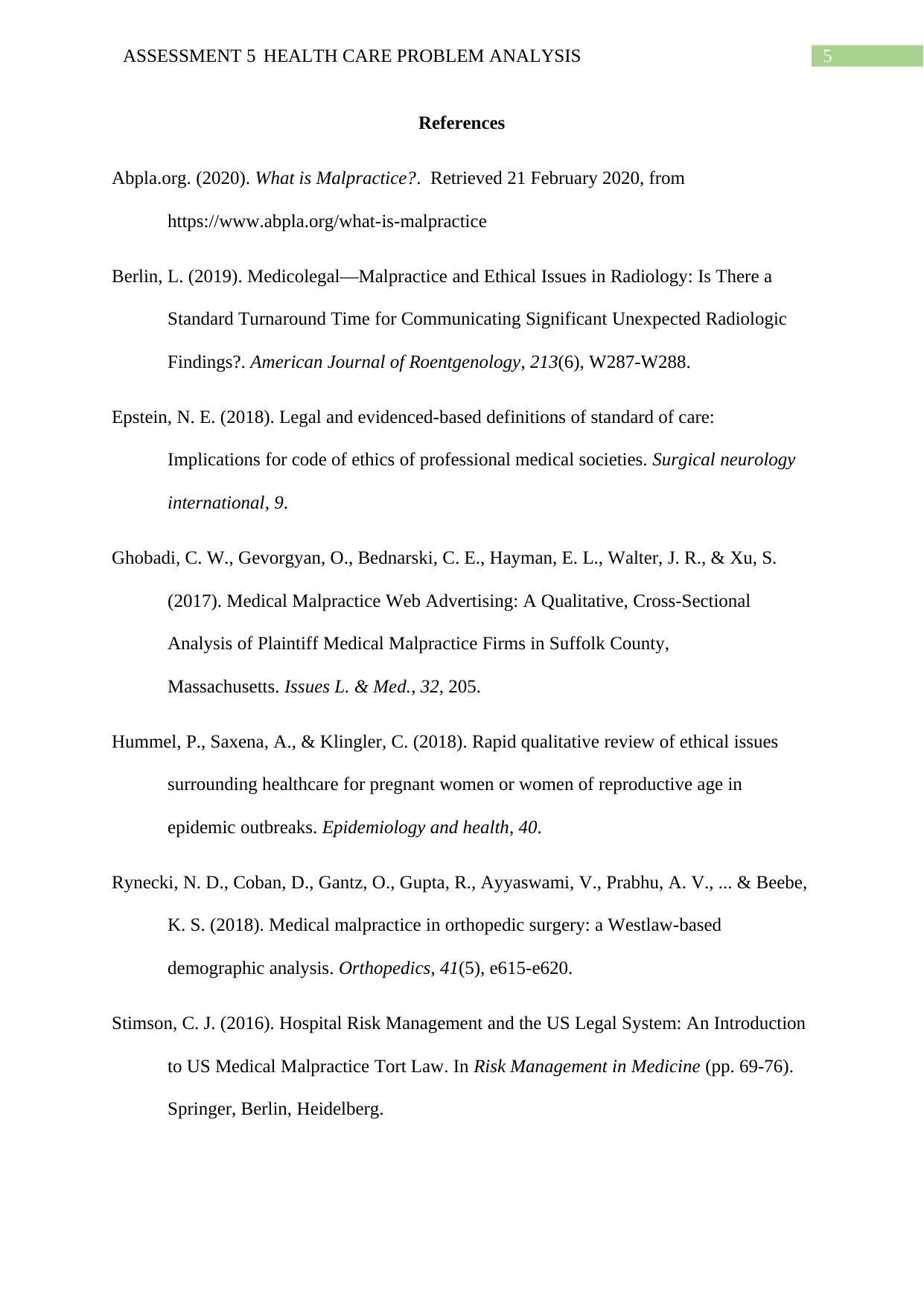
5ASSESSMENT 5 HEALTH CARE PROBLEM ANALYSIS
References
Abpla.org. (2020). What is Malpractice?. Retrieved 21 February 2020, from
https://www.abpla.org/what-is-malpractice
Berlin, L. (2019). Medicolegal—Malpractice and Ethical Issues in Radiology: Is There a
Standard Turnaround Time for Communicating Significant Unexpected Radiologic
Findings?. American Journal of Roentgenology, 213(6), W287-W288.
Epstein, N. E. (2018). Legal and evidenced-based definitions of standard of care:
Implications for code of ethics of professional medical societies. Surgical neurology
international, 9.
Ghobadi, C. W., Gevorgyan, O., Bednarski, C. E., Hayman, E. L., Walter, J. R., & Xu, S.
(2017). Medical Malpractice Web Advertising: A Qualitative, Cross-Sectional
Analysis of Plaintiff Medical Malpractice Firms in Suffolk County,
Massachusetts. Issues L. & Med., 32, 205.
Hummel, P., Saxena, A., & Klingler, C. (2018). Rapid qualitative review of ethical issues
surrounding healthcare for pregnant women or women of reproductive age in
epidemic outbreaks. Epidemiology and health, 40.
Rynecki, N. D., Coban, D., Gantz, O., Gupta, R., Ayyaswami, V., Prabhu, A. V., ... & Beebe,
K. S. (2018). Medical malpractice in orthopedic surgery: a Westlaw-based
demographic analysis. Orthopedics, 41(5), e615-e620.
Stimson, C. J. (2016). Hospital Risk Management and the US Legal System: An Introduction
to US Medical Malpractice Tort Law. In Risk Management in Medicine (pp. 69-76).
Springer, Berlin, Heidelberg.
References
Abpla.org. (2020). What is Malpractice?. Retrieved 21 February 2020, from
https://www.abpla.org/what-is-malpractice
Berlin, L. (2019). Medicolegal—Malpractice and Ethical Issues in Radiology: Is There a
Standard Turnaround Time for Communicating Significant Unexpected Radiologic
Findings?. American Journal of Roentgenology, 213(6), W287-W288.
Epstein, N. E. (2018). Legal and evidenced-based definitions of standard of care:
Implications for code of ethics of professional medical societies. Surgical neurology
international, 9.
Ghobadi, C. W., Gevorgyan, O., Bednarski, C. E., Hayman, E. L., Walter, J. R., & Xu, S.
(2017). Medical Malpractice Web Advertising: A Qualitative, Cross-Sectional
Analysis of Plaintiff Medical Malpractice Firms in Suffolk County,
Massachusetts. Issues L. & Med., 32, 205.
Hummel, P., Saxena, A., & Klingler, C. (2018). Rapid qualitative review of ethical issues
surrounding healthcare for pregnant women or women of reproductive age in
epidemic outbreaks. Epidemiology and health, 40.
Rynecki, N. D., Coban, D., Gantz, O., Gupta, R., Ayyaswami, V., Prabhu, A. V., ... & Beebe,
K. S. (2018). Medical malpractice in orthopedic surgery: a Westlaw-based
demographic analysis. Orthopedics, 41(5), e615-e620.
Stimson, C. J. (2016). Hospital Risk Management and the US Legal System: An Introduction
to US Medical Malpractice Tort Law. In Risk Management in Medicine (pp. 69-76).
Springer, Berlin, Heidelberg.
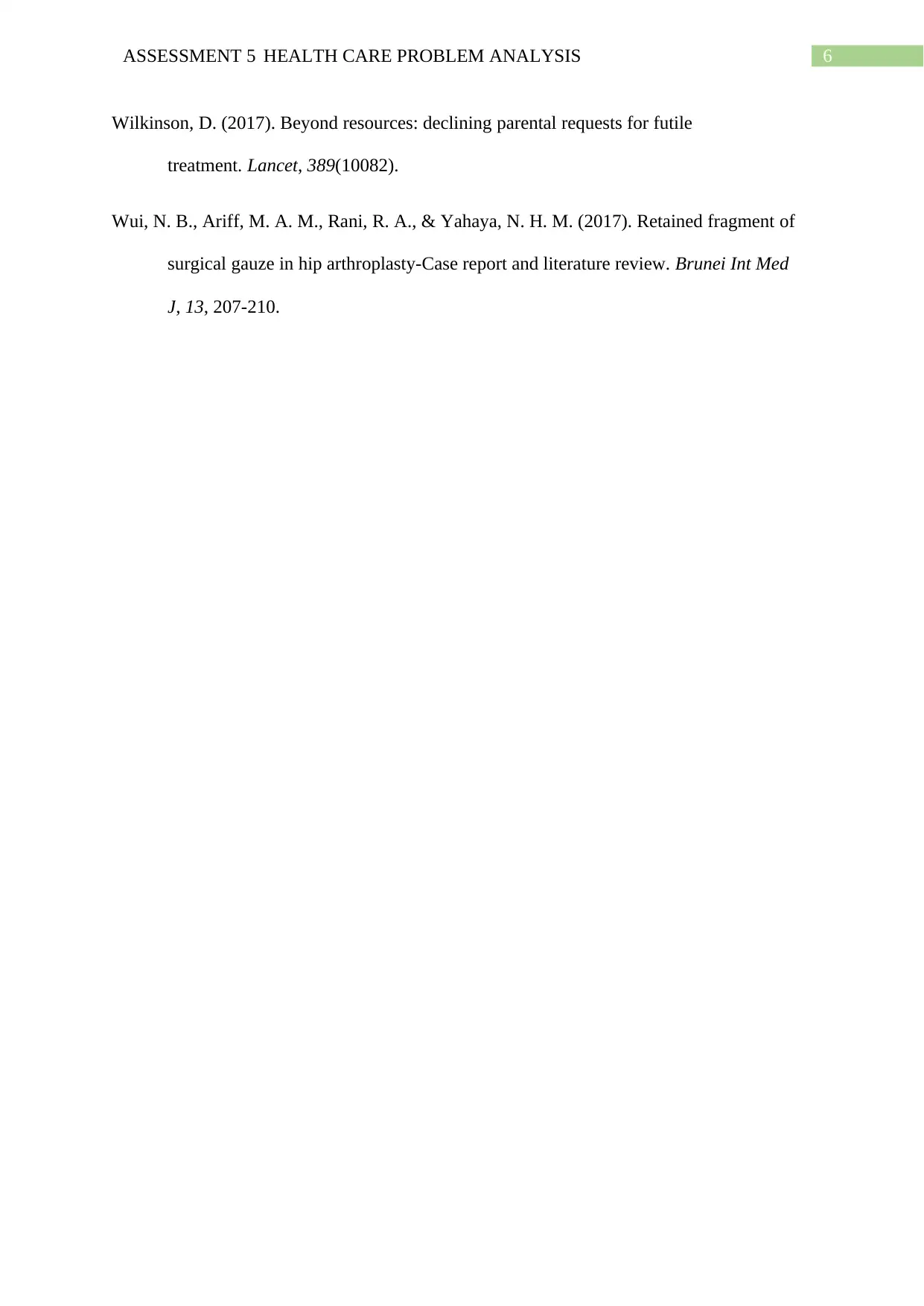
6ASSESSMENT 5 HEALTH CARE PROBLEM ANALYSIS
Wilkinson, D. (2017). Beyond resources: declining parental requests for futile
treatment. Lancet, 389(10082).
Wui, N. B., Ariff, M. A. M., Rani, R. A., & Yahaya, N. H. M. (2017). Retained fragment of
surgical gauze in hip arthroplasty-Case report and literature review. Brunei Int Med
J, 13, 207-210.
Wilkinson, D. (2017). Beyond resources: declining parental requests for futile
treatment. Lancet, 389(10082).
Wui, N. B., Ariff, M. A. M., Rani, R. A., & Yahaya, N. H. M. (2017). Retained fragment of
surgical gauze in hip arthroplasty-Case report and literature review. Brunei Int Med
J, 13, 207-210.
⊘ This is a preview!⊘
Do you want full access?
Subscribe today to unlock all pages.

Trusted by 1+ million students worldwide
1 out of 6
Related Documents
Your All-in-One AI-Powered Toolkit for Academic Success.
+13062052269
info@desklib.com
Available 24*7 on WhatsApp / Email
![[object Object]](/_next/static/media/star-bottom.7253800d.svg)
Unlock your academic potential
Copyright © 2020–2025 A2Z Services. All Rights Reserved. Developed and managed by ZUCOL.





